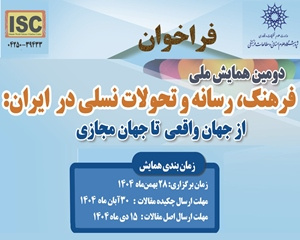بررسی پیوند میان دین و عرفان و تصوف در سده ی سوم هجری
آرشیو
چکیده
یکی از مباحثی که همواره در میان اندیشمندان دین پژوه محل بحث و اختلاف دیدگاه بوده، بحث ارتباط دین و عرفان است. هر یک از این بزرگان کوشیده اند با رویکردی خاص به تحلیل رابطه ی این دو بپردازند و نهایتا دیدگاه خود را مطرح کردهاند. نگاهی به پیشینهی این مباحث نشان می دهد که آرا و اقوال در این زمینه بسیار متفاوت و گاه متناقضند: گروهی بر این باورند که عرفان ضد دین است؛ گروهی دیگر عرفان را بیگانه از دین میدانند؛ برخی عرفان را عین دین و گروهی نیز عرفان را قلب و گوهر دین تفسیر میکنند. در تحلیلی دیگر عرفان بخشی از دین معرفی میشود و در تحلیلی، باطن دین. بررسی ژرف این دیدگاهها نشانگر این گفتنی مهم است که دلیل اساسی این همه تفاوت و تناقض دیدگاه در بررسی رابطهی میان دین و عرفان در این حقیقت نهفته است که اغلب این بزرگان تنها بخشی از عرفان و دیدگاههای عرفا را ملاک بحث و تحلیل خود قرار دادهاند و نهایتاً یافته های خود را تعمیم داده اند؛ حال آنکه عرفان و تصوف در هر دوره ویژگی های خاص خود را داشته است و تنها با بررسی موشکافانهی هر سده و گاه هر دهه میتوان رابطه ی خاص دین و عرفان را در آن دورهی خاص تبیین کرد. نگارندگان در این جستار کوشیدهاند این نکتهی اساسی را فرا روی خود قرار دهند و بر این اساس به تبیین رابطهی میان این دو در سدهی سوم هجری- یکی از مهمترین ادوار عرفان ایرانی، اسلامی- بپردازند. این جستار در 5 بخش ارائه میشود: 1- مقدمه. 2- وضع عمومی عرفان و تصوف در سدهی سوم هجری. 3- معرفی عرفا و دیدگاههای خاص آنها. 4- تحلیل رابطهی دین و عرفان در سدهی سوم هجری. 5- نتیجه گیری.A study of the connection between religion, mysticism and Sufism in the third century AH
One of the topics that has always been debated among theologians is the connection between religion and mysticism. A look at the background of these discussions shows that opinions and sayings in this field are very different and sometimes contradictory: some believe that mysticism is anti-religion; Another group considers mysticism to be alien to religion; Some interpret mysticism as religion and some interpret mysticism as the heart and essence of religion. In another analysis, mysticism is introduced as a part of religion and in another analysis, the essence of religion. An in-depth examination of these views shows that the main reason for all these differences and contradictions lies in the fact that most of these great men have used only a part of mysticism and mystics' views as the basis for their discussion and analysis. However, mysticism and Sufism have their own characteristics in each period, and only a careful study of each century and sometimes each decade can explain the specific relationship between religion and mysticism in that particular period. In this article, the authors have tried to address this basic point and based on this to explain the relationship between the two in the third century AH - one of the most important periods of Iranian, Islamic mysticism –








